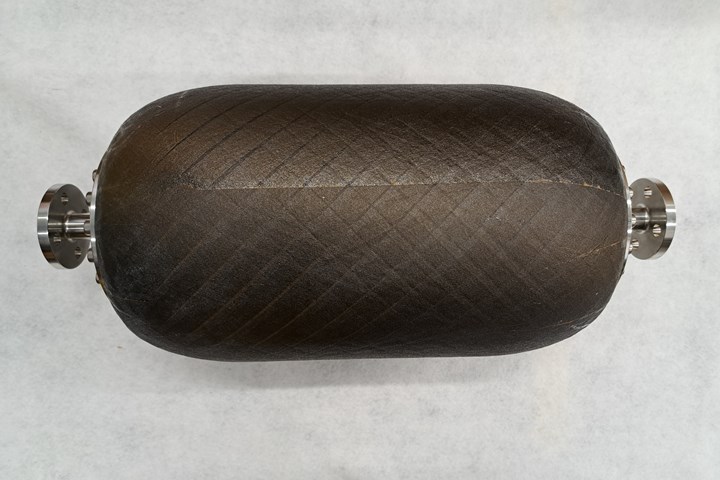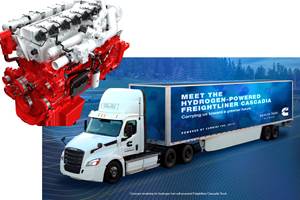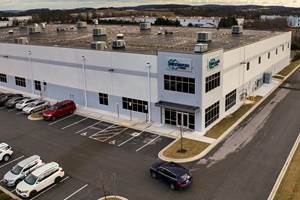NCC reaches milestone in composite cryogenic hydrogen program
The National Composites Centre is testing composite cryogenic storage tank demonstrators with increasing complexity, to support U.K. transition to the hydrogen economy.

The National Composites Centre (NCC, Bristol, U.K.) has announced a U.K.-based composite cryogenic storage tank testing program that will validate and accelerate design, manufacture and test capabilities, starting with a linerless carbon fiber tank for storing liquid hydrogen (LH2).
Cryogenic storage tanks will be essential components in hydrogen-powered aircraft due to come into service in the mid-2030s. Most designs for storing LH2 have centered around metallic tanks, which are relatively heavy. Composite tanks developed in the space industry tend to be suited only for single-use (low-cycle) applications. However, commercial hydrogen aircraft will need fuel tanks to be as light as possible, filled and emptied numerous times (high cycle), and last for several decades.
To support the U.K.’s transition to a low-carbon economy, the NCC is developing underpinning knowledge for composite cryogenic storage tanks and testing by developing product demonstrators with increasing complexity. Its team of specialist engineers have also created and built a range of comprehensive cryogenic concepting and design tools to help UK organizations overcome known engineering challenges critical to accelerating hydrogen development.
With no clear existing industry standards for aerospace cryogenic tanks, the ability to analyze a range of designs is essential. This led to the development of a range of concepting tools covering tank design space exploration, permeability, microcracking, thermal and mechanical stresses. These tools form a baseline toolset that can be used by industry for cryogenic tank projects, enabling detailed design and manufacturing risk identification and analysis. Understanding cryogenics at this fundamental level will enable the NCC to support a wide range of industries and applications, each facing separate but overlapping challenges.
Testing is a crucial part of the cryogenic tank development program, which currently requires access to specialist testing facilities. For example, LH2 requires well-insulated cryogenic storage vessels to maintain it at a temperature of -253°C, and handling requires specialist knowledge and equipment.
To develop a U.K.-based testing capability for its customers, the NCC has partnered with Filton Systems Engineering (FSE), a Bristol-based SME specializing in fluid system engineering, that owns and operates a hydrogen test facility capable of both gaseous and liquid hydrogen testing. Working in partnership with FSE, the NCC has developed a tank-testing program that uses an LH2 vacuum test chamber and cryo-rated testing instrumentation. As a world-leading composites research and development center, the NCC has designed and manufactured five linerless carbon fiber demonstrator tanks, using a mix of automated fiber placement (AFP), tape winding, and hand lay-up composite processes. The tanks will be used for the liquid hydrogen testing program, starting at the end of April 2023, with results expected summer 2023.
Daniel Galpin, Advanced Research Engineer, NCC, says, “The cross-sector capability we’ve developed will enable U.K. industry to accelerate and advance engineering expertise in composite cryogenic storage, and secure future commercial competitiveness. Our comprehensive program will enable us to support customers on their journey to design, validate, manufacture, and test high-cycle composite cryogenic tanks.”
The NCC Hydrogen team is collaborating with partners and the supply chain to advance engineering expertise in composite cryogenic storage systems that will help the U.K. to achieve its net-zero ambitions. This builds on NCC’s investment in capability development for hydrogen pressure vessels and hydrogen smart pipes: two other areas that will help establish a strong H2 supply chain as the Government implements its U.K. Hydrogen Strategy to kick-start a vibrant hydrogen economy by 2030. Expertise and knowledge developed through the focus on cryogenics has enormous potential for numerous cross sector applications and will guide technology development.
Related Content
JEC World 2022, Part 1: Highlights in sustainable, digital, industrialized composites
JEC World 2022 offered numerous new developments in composites materials, processes and applications, according to CW senior editor, Ginger Gardiner, most targeting improved sustainability for wider applications.
Read MoreTU Munich develops cuboidal conformable tanks using carbon fiber composites for increased hydrogen storage
Flat tank enabling standard platform for BEV and FCEV uses thermoplastic and thermoset composites, overwrapped skeleton design in pursuit of 25% more H2 storage.
Read MoreCummins debuts 15-liter hydrogen engine and partners with Daimler for fuel cell trucks
Full-scale production of H2 ICE expected in 2027 while Daimler Truck will have initial fuel cell trucks available to select North American customers in 2024.
Read MoreHexagon Purus opens new U.S. facility to manufacture composite hydrogen tanks
CW attends the opening of Westminster, Maryland, site and shares the company’s history, vision and leading role in H2 storage systems.
Read MoreRead Next
CW’s 2024 Top Shops survey offers new approach to benchmarking
Respondents that complete the survey by April 30, 2024, have the chance to be recognized as an honoree.
Read MoreComposites end markets: Energy (2024)
Composites are used widely in oil/gas, wind and other renewable energy applications. Despite market challenges, growth potential and innovation for composites continue.
Read MoreFrom the CW Archives: The tale of the thermoplastic cryotank
In 2006, guest columnist Bob Hartunian related the story of his efforts two decades prior, while at McDonnell Douglas, to develop a thermoplastic composite crytank for hydrogen storage. He learned a lot of lessons.
Read More
.png;width=70;height=70;mode=crop)
























